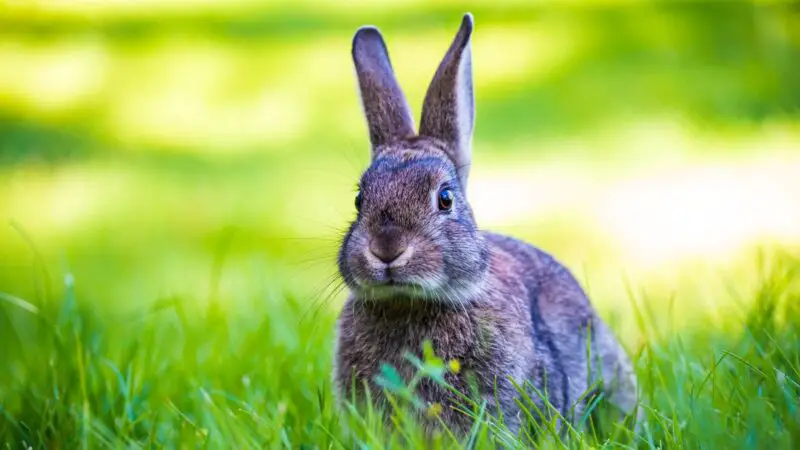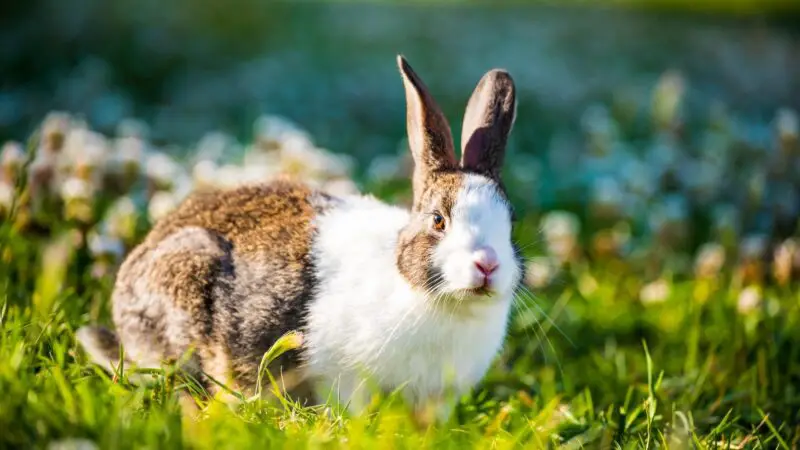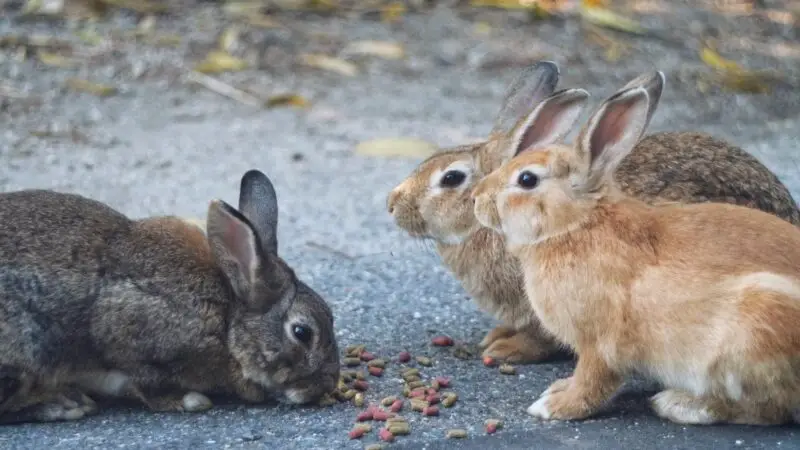Even if rabbits can’t perspire, they’re covered in thick fur that makes them prone to overheating or hyperthermia which is why they should be kept out of direct sunlight.
Rabbits are extra vulnerable during summer since the heat can get a little intense for these creatures. It’s important to know how to take care of them and ensure they’re kept cool during this season.
So, what are ways of keeping your rabbits cool in the summer? You can help by buying cooling mats, ensuring their homes are protected from the sun, soaking their food in ice water, and providing cool water for drinking. Additionally, you can trim their fur, use a fan, fill bottles with iced water, spray water, lay the rabbits on ceramic tiles, and dig up warrens.
If you’re looking for ways to protect your rabbits against the scorching heat, look no further, as this article will provide you with everything you need to know and more!
10 Effective Ways to Keep Your Rabbits Cool in Summer

1. Think About Purchasing a Special Self-Cooling Mat
Cooling mats are exactly what their names suggest. These are pieces of fabric or other materials that are placed on the floor or the bottom of their enclosures to radiate coolness for your rabbits.
The ideal cooling pads are those that are non-toxic to rabbits and made of bite-resistant materials.
- Instantly COOLS when your small animals sits on it
- Bite resistant
- No need to refrigerate
- Re-usable
- Great for hutches
2. You Might Want to Think About Bathing Your Rabbits’ Leafy Greens in Icy Water
Keeping them well-fed by providing well-cleaned and plenty of vegetables is the best cooling method. Fresh hay grasses and leafy green vegetables make up the bulk of rabbits’ diets.
You can help your rabbits digest cold and refreshing food by soaking 2 to 4 cups of veggies in ice water or refrigerating them before serving.
The ideal veggies to feed them are parsley, lettuce, broccoli, spinach, kale, turnip greens, endive, and mustard greens. Carrots, carrot tops, bell peppers, and zucchinis can also be used.
Make sure to feed them a variety of these items by mixing and matching. You can also try giving a tablespoon or two of fresh, low-sugar cold fruits (e.g. apples, grapes, oranges) as a treat but only once or twice a week.
3. Make Sure That the Rabbit’s Hutch, as Well as the Play Area, Are in the Shade
If possible, keep your rabbits indoors. But if you prefer placing them outdoors, their hutches should be shaded by adding materials that can serve as makeshift roofs or awnings.
Hutch floors should also be wired to maintain good ventilation. You can also try painting the walls or outside parts of the hutches with white paint to reflect some of the sun’s heat.
4. Give Your Bunnies a Trim
It’s recommended to see your local pet barber for this job because you might accidentally hurt your rabbits in the process of trimming their fur.
However, if you plan on doing the trimming yourself, keep in mind the following tips:
- Brush their fur to remove any excess and to help prevent them from ingesting fur. Clean their eyes using damp cotton balls if there is fur present. Do the same for their ears, feet, chin, and genital areas.
- Clean off any urine or fecal waste on your rabbit. Check for potential parasites such as fleas, ticks, and mites.
- You can use a shaving tool, trimmer, clipper, or blunt-tipped scissors to cut their fur. Don’t trim areas where you can’t see the skin or roots of the fur. Remember that rabbit skin is extremely fragile due to its thinness and elasticity.
5. Change the Rabbits’ Water a Couple of Times a Day to Keep It Fresh and Cool
Aside from regularly giving them fresh and cool water, rabbits drink twice as much water as they eat meals during the summer season compared to how much they normally consume. By the time you plan on replacing their water, they’ve already most likely finished drinking it all.
6. A Fan Can Be Used to Keep the Air Cool and Create Airflow
Fans, regardless of size, should be able to offer ventilation without creating air drafts around the rabbits. Ensure that you’re not placing the fans directly in front of the rabbits.
You can also try placing a cold, damp towel outside their hutches and letting the fan blow through it to help cool the airflow and temperature.
7. Spray Water Behind the Ears of the Rabbit
Rabbits regulate their body temperatures and release body heat through their ears. Spritzing cold, but not icy, water using a spray bottle will help them cool off. Make sure you don’t directly spray them into their ear canals. This method gives temporary relief to your rabbits and may be done a couple of times a week.
8. Fill Large 2 Liter Soda Bottles With Water and Then Freeze Them
Use them as alternative ice packs. Place them beneath hutches or cages for extra cool ventilation throughout their living spaces.
You can also wrap them in towels and put them directly inside their enclosures. Your rabbits will flock onto the cold source and treat it like a makeshift air conditioner.
9. Give Your Bunnies Cool Ceramic Tiles to Lay On
Only do so, however, if your rabbits and bunnies don’t mind constantly slipping on the tiles.
Rabbits generally dislike or are afraid of slick surfaces due to the lack of friction that they’re used to, especially ones that are kept outside and are used to walking on the ground.
If your rabbits are alright with the ceramic tiles, then definitely go for it. Tile stores will have discontinued products that are sold cheaper compared to new stocks but are still capable of giving your bunnies something cool to lie on.
10. Create Warrens for Your Bunnies to Burrow Into
Rabbits in the wild dig underground burrows called warrens to keep out of reach from direct sunlight and to feel the Earth’s natural coolness during the summer. Constructing manmade warrens can encourage your rabbits to seek refuge in the ground.
Related Questions
What Temperature Is Too Hot for Rabbits?

Rabbits have a difficult time living in highly humid environments with temperatures above 90°F since their fur coats are thick.
Ideal temperatures that they could live in are 60°F to 65°F. Going beyond this will discourage rabbits from eating, and they will tend to consume a lot of energy trying to keep cool and remove their body heat.
How Do Rabbits Regulate Their Temperature?
Regulating body temperature is a function of rabbits’ ears. When their body temperatures increase, blood flow in the ears also increases due to the expansion of blood vessels. Heat escapes through their breaths by panting and using other air movements across their bodies.
In hot temperatures around 77°F to 86°F, rabbits will stretch their bodies to lose heat, including their ears. If it goes beyond that, they are virtually incapable of regulating their body heat themselves and might experience a heat stroke.
In cold temperatures below 50°F, rabbits lower their ear temperatures to adapt and fold their ears inwards to prevent coming in direct contact with the cold air.
What Are the Signs of Heat Stroke in Rabbits?
Typical symptoms are excessive panting, salivating (sometimes bloody discharges), wet mouths and noses, weakness or going unconscious, blue or reddening ears, tongues, and lips, increased heart rates, and rapid breathing.
What to Do if Your Rabbit Is Having a Heat Stroke?
Immediately cool your rabbit by placing a cold, damp towel over their hutches or enclosures, encouraging them to gradually sip cool water, wipe or spray cool water behind their ears, and transfer their homes to cooler areas.
What Not to Do for Heatstroke in Rabbits?
Don’t submerge them in cool baths or water as it might come as a shock to them and worsen the situation. Heat strokes can be fatal for rabbits, especially if they can no longer control their body temperatures to adapt to the heat.
Is It Safe to Eat Rabbit in the Summer?
It is not safe to rabbit in the summer because warmer weathers help the proliferation and transmission of parasites and diseases among wild rabbits, squirrels, and rodents since they are the most susceptible animals.
Ingesting rabbits during the summer will increase the risk of catching diseases such as tularemia, or rabbit fever, which causes skin ulcers, pneumonia, and diarrhea, among other symptoms.
Do Rabbits Eat Less in Summer?

Rabbits eat less in summer. Decreasing food intake is one of their coping mechanisms when feeling hot.
Can Rabbits Breed in the Summer?
Rabbits can breed in the summer. However, mortality rates for their young will be high. Stress due to heat can cause sterility among rabbits which can affect reproduction.
They may end up with complications such as miscarriage, aborting their babies, not being able to take proper care of them when they’re born, delivering them outside of designated nest boxes, or worse, death for both the parent and the babies.
Rabbits should constantly be kept cool in the summer to avoid the risk of heat strokes. Rabbit owners can do so by keeping their living environments cool, trimming their fur, and making sure they’re well-fed with cool vegetables, fruit treats, and enough water.
Purchasing and utilizing cooling items such as cooling mats, fans, and ceramic tiles can also help rabbits cool down.
List of Sources
How to Avoid Tularemia, Rare ‘Rabbit Fever’ Reported in Northern Colorado
Rabbits: From the Animal’s Point of View: What Does It Mean to Be a Rabbit

